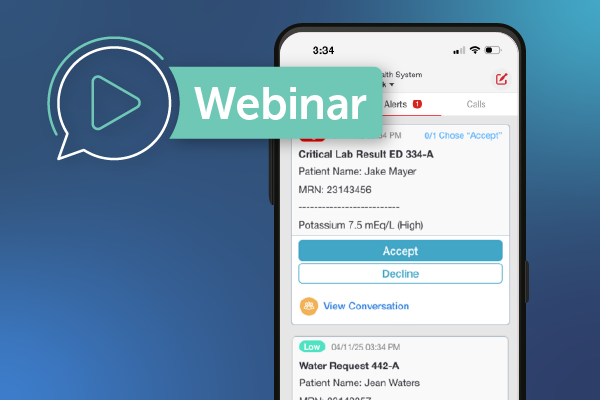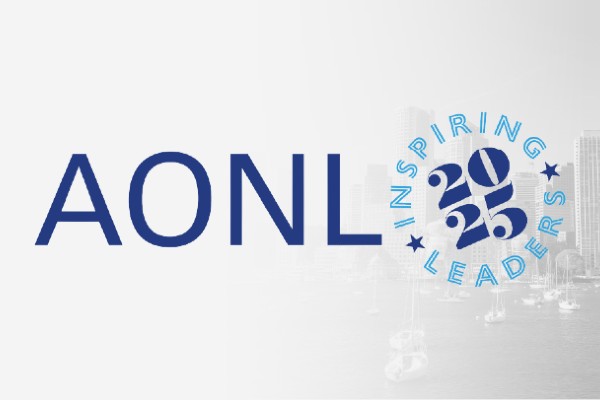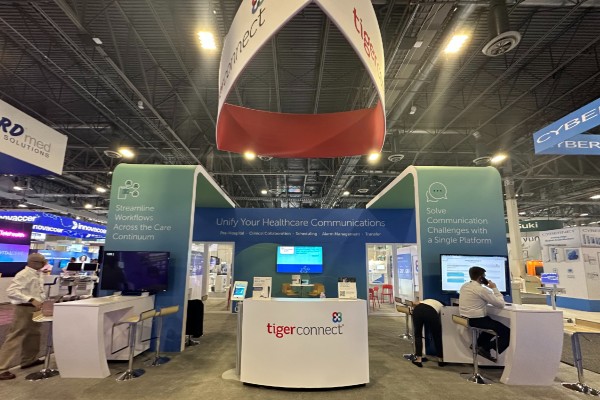
Why does clinical communication matter?
Clinical workflows enable doctors, nurses, and other healthcare professionals to coordinate effectively and provide the best quality care for their patients. Each caregiver on the team has a unique and critical part to play. The communication between team members who work either with each other or across different hospital departments must flow flawlessly.
Gaps in communication drive the majority of medical errors. Unclear communication between hospital employees can easily lead to poor patient care, including clinicians missing important information and procedures not being taken care of on time. What happens when the patient has already received medication but the nurse has failed to note it? Or it’s reported in a low-visibility location? Pertinent information is at the forefront of patient care.
An excellent clinical workflow allows healthcare professionals to seamlessly care for patients by eliminating gaps in communication.

Unify Your Clinical Communication
Learn how a dedicated clinical communication and collaboration platform can improve clinical workflows.
What is clinical workflow?
A quality clinical workflow requires a clinical communication and collaboration platform to get the correct information to the right person at the right time. CC&C platforms streamline workflows, creating the foundation of clinical communication and collaboration between caregivers, allied health, and administrative users. Much like a person’s ability to adapt and “move with the flow,” a clinical workflow should be able to respond to rapidly changing scenarios. According to the Institute of Medicine, the use of health information technology in a healthcare organization is vital in establishing a healthcare system that is [1]:
- Safe
- Works well
- Patient-centered
- Efficient
- Timely
- Equitable
Through integrations with EHRs, roles-based scheduling tools, and alerts and alarm systems, today’s clinical communication and collaboration solutions improve the exchange of information among clinical teams and overall clinical workflow.
Best practices for an excellent clinical workflow
A streamlined clinical workflow leads to better patient outcomes. Some of the features to look for in your clinical workflow solution include:
- Roles-based shift handoff. This feature ensures continuity between day shift and night shift nurses and other healthcare professionals. Patients must continue to receive the same care even as their nurse or on-call physician switches to a new provider. Therefore, communication and information exchange between shifts should be role-based. This ensures that care teams can easily find the right nurse or physician on time.
- Automated on-call scheduling. Physician scheduling software can not only make life easier for care teams, but it can also streamline overall clinical workflows. Today, many clinicians still rely on whiteboards and biners to coordinate schedules. On-call scheduling software makes the schedule readily available on your smartphone, so it’s easy for staff to both know and reach who’s on-call by role. The tool enables teams to communicate scheduling changes instantly, coordinate time-off requests, see future shift assignments, and ensure fairness in shift assignments.
- Nurse call alert system. Not all nurse calls require notifying the assigned RN. Non-priority alerts (such as beverages, ice chips, and blanket requests) can be routed to allied health. Sending every alert to the RN can lead to alarm fatigue, unnecessary clinical interruptions, and inefficient clinical workflow. Nurse call alert systems streamline your nurse call workflow with real-time, prioritized triage. If the primary nurse is unavailable, the alert will auto-escalate to the next care team member.
- Activation of a rapid response team. When a patient is in a “code” situation requiring urgent attention, immediate care is crucial. An excellent clinical workflow will include a fast and efficient way to notify specialists or teams of specialists, ideally through a roles-based, secure messaging service with priority alerts. With one click, nurses can instantaneously get help at the patient’s bedside.
- EHR integration. 61% of physicians find that EHRs negatively affect their workflow. A good technology solution to improve clinical workflow takes this point into account and makes it simple to securely access EHRs, add information to EHRs, and share relevant information such as lab alerts. Seamless health IT integration is essential for clinical communication and collaboration and is a cornerstone of a successful clinical workflow.
- Post-discharge communication. Patient communication is critical within the first two days to avoid post-discharge readmissions, which can be expensive and negatively impact a patient’s progress. An excellent clinical workflow considers that the patient or their family might have questions about their care. That’s why a clinical collaboration solution should also include a component for two-way communication with patients. Physicians can securely message, call, or video chat with patients with a single tap from their app.
Excellent clinical communication and collaboration directly impact hospital expenses, a patient’s quality of care, patient experiences, and provider experiences. In addition, it can lower risk by reducing alarm fatigue and medical errors and speed up patient care by enabling providers to communicate efficiently. Following these clinical workflow best practices can potentially lead to more revenue by increasing patient volume and capacity.
More than a communication platform
Multiple systems can lead to fragmented communication and additional challenges for health systems. That’s why we’ve developed a single solution to reduce administrative burden, improve clinical workflow and bring care teams together. If your organization is ready to better manage patient flow throughout the entire care cycle with a solution that integrates, consolidates, and intelligently routes data from multiple sources, contact TigerConnect today.
References
- Unertl KM, Novak LL, Johnson KB, Lorenzi NM. Traversing the many paths of workflow research: developing a conceptual framework of workflow terminology through a systematic literature review. J Am Med Inform Assoc. 2010;17(3):265-273. doi:10.1136/jamia.2010.004333
- Zheng K, Haftel HM, Hirschl RB, O’Reilly M, Hanauer DA. Quantifying the impact of health IT implementations on clinical workflow: a new methodological perspective. Journal of the American Medical Informatics Association. 2010;17(4):454-461. doi:10.1136/jamia.2010.004440
Featured Resources
Related Articles













